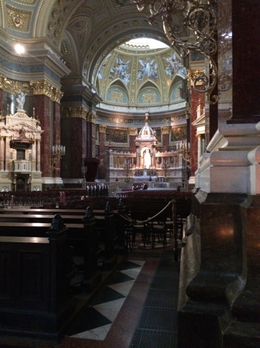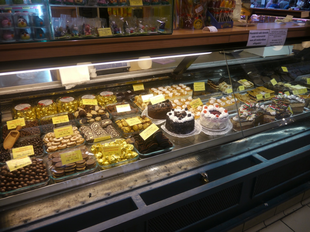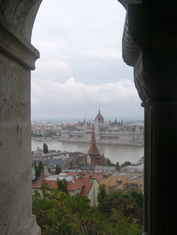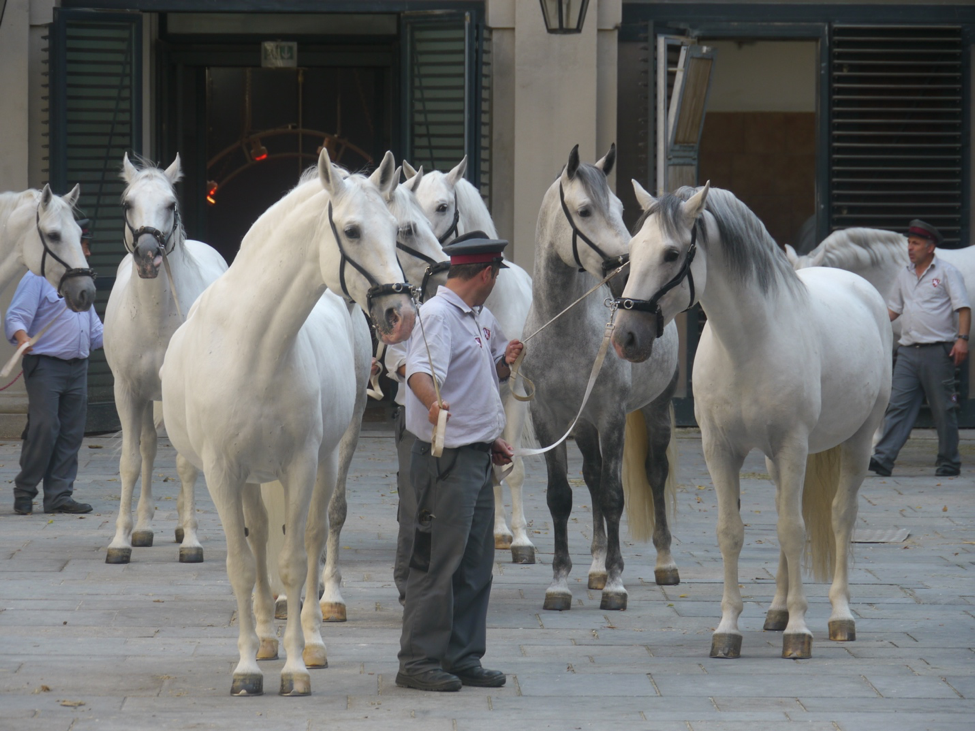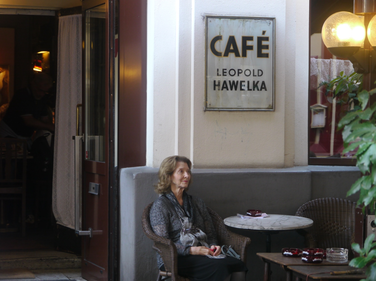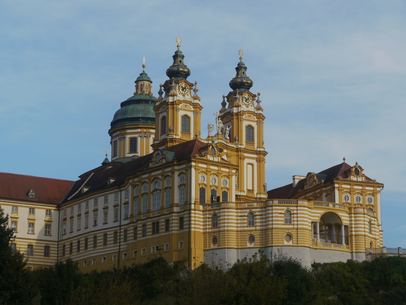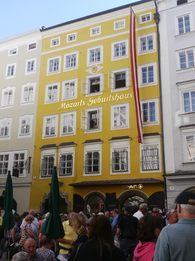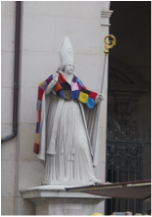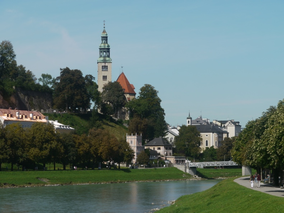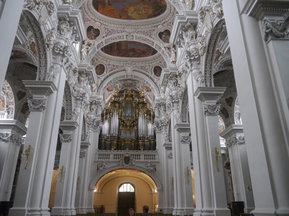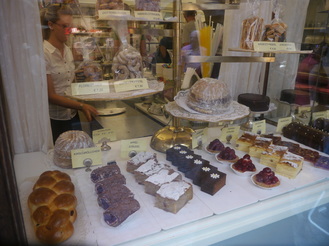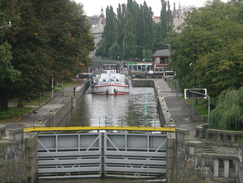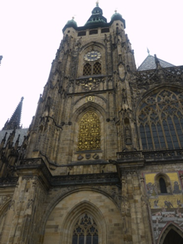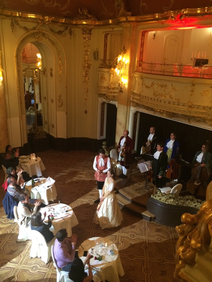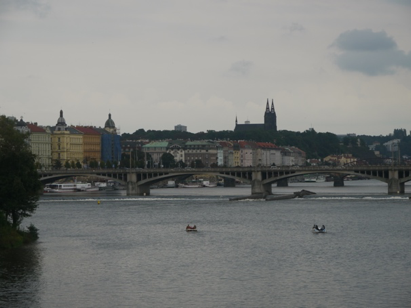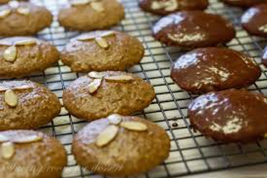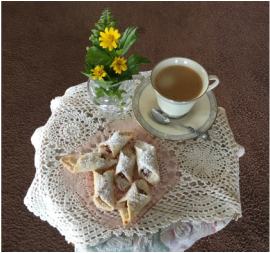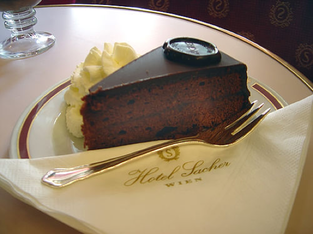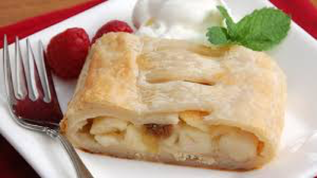Many other beautiful moments awaited us in Budapest—the gorgeous Baroque Opera House, the huge castle complex with its medieval Fishermen’s Bastion high above the river, a visit to a charming old thermal bath house filled with bathers young and old, and bakeries overflowing with luscious Hungarian pastries, filled with poppy seeds and apricot jam
Wild geese in cold rain
Cross the Danube above the
Chain Bridge flying south.
Vienna, a jewel of a city, greeted us as we disembarked. Here we visited the glorious St. Stephen’s Cathedral and marveled at a Mozart and Strauss concert at the Habsburg Palace. This Baroque architectural masterpiece is home not only to the President of Austria, but to glorious art, furnishing and music, as well as none other than the Lipizzaner Stallions, whose “bedrooms” are in the palace itself. We met these handsome creatures by accident on a walking tour of the city.
Back on the ship, we cruised through some of the Danube’s most beautiful landscapes where iridescent green-necked mallards floated downstream and dew-covered purple clover glistened in the autumn sunlight. We made brief stops at the beautiful medieval towns of Durnstein and Melk, both worth a visit for their historic and artistic significance. I am embarrassed to say that before this journey, Melk and its magnificent thousand-year-old Benedictine Abbey, was utterly unknown to me. Originally a royal palace perched high on a hill overlooking the river, the entire complex became an abbey in 1089 when Leopold II, Margrave of Austria, gifted it to the Benedictine order of monks. In the Middle Ages, the abbey became famous for its extensive library of manuscripts and its scriptorium where religious documents were laboriously hand written and decorated by the monks. Today, guests can visit the Abbey’s library and museum where a breathtaking collection of religious objects and manuscripts, many depicting liturgical music, are beautifully displayed. Stunned by the library’s treasures, we were nearly overwhelmed by the interior of the Abbey Church, redesigned in the 1700s in the Baroque style and considered one of the finest examples of Baroque architecture in all of Europe. The high, octagonal dome, twin spires, glorious frescoes, all filled with light from the many windows, create a golden glow that literally lifts the heart and leads the eye upward in a celebration of beauty that encompasses all of the senses.
On our final evening in Prague, we treated ourselves to the Mozart Dinner at the Grand Hotel Bohemia, a 1920s era Neo-Baroque extravaganza reminiscent of any number of Hollywood movie sets. In the opulent Boccaccio Hall, we relished our three course dinner from our Balcony Box as a costumed orchestra and opera singers thrilled us with Mozart’s music and arias between each course. Good food and “A Little Night Music.” Our happiness was complete.
More than three hundred years ago, in Vienna and other cities along the Danube, “café society” evolved as an interpersonal and aesthetic experience. Coffee Houses emerged as places where friends could gather to read the local newspapers, listen to a string quartet play the latest by Haydn or Mozart, and discuss art, literature and music. Guests were welcome to linger as long as they wished, savoring perhaps a Kapuziner (cappuccino) or a Kaffee Crème (coffee with a small jug of milk on the side,) along with a pastry such as Apple Strudel or the famous Sacher Torte.
Patrons of the arts often opened their own homes as “salons” where like-minded friends might be invited to hear Brahms or Liszt play their own compositions on the family piano as the guests sipped strong black coffee with cream and enjoyed freshly baked pastries. You and your friends can enjoy this Central European version of “Afternoon Tea” in your home. This is the time to use your silver tray, if you have one, to serve the pastries, along with your best china and linens.
If you have a tablecloth with lace, use it, and by all means, play some Baroque, Neoclassical or Romantic era chamber music as the guests arrive. You cannot go wrong with Haydn, Mozart or Brahms.
For this gathering, we will forgo the English-inspired sandwich and scone courses and focus solely on Coffee and Pastry to give you time to bake the pastries in the morning. European pastries are always best when they are truly fresh, and the recipes were developed before refrigeration. Genuinely fresh pastries are almost impossible to find in American chain coffee houses where the pastries languish in refrigerated cases for far too long, and yet are sold as “fresh” pastries. Your guests will be astounded at how wonderful fresh European pastries really are. The German and Hungarian cookies on our menu are also divine, and fortunately you can make then the day before your Coffee and Dessert party.
Beverages:
Strong Dark Coffee with Milk or Cream
Hot Chocolate with Whipped Cream: (Use the recipe for Hot Chocolate in Afternoon Tea for Children in the Afternoon Tea for Special Occasions section of myteaplanner.com and substitute freshly whipped cream for the marshmallows.)
Cherry Flavored Tisane
Cookies and Candies:
Lebkuchen: German “Love Cookies”
Kiffles: Hungarian Cream Cheese Cookies with Prune or Apricot Lekvar
Mozart Chocolates (Order on line or purchase at a European import shop.)
Pastries:
Sacher Torte
Easy Apple Strudel
These cookies are very popular in Germany at Christmas time, but truthfully, they are so good that Germans enjoy them all year round. Lebkuchen are often referred to as “German Gingerbread,” although several of the recipes I researched contain no ginger at all. German purists use a spice mix, similar to Chinese Five Spice, to flavor these cookies. The mix is called Lebkuchengewurz in German, and the version of this mix that we will use does contain some ginger. Traditional Lebkuchen also contain candied orange and lemon peel, but we have opted to include freshly grated orange and lemon peel instead. If you wish to go old school, add about a third of a cup each of finely chopped candied lemon and orange peel to the Lebkuchen batter. You can find a recipe for homemade candied citrus peel in the “In Defense of Fruitcake” section of “A Christmas Tea” in the December calendar section of myteaplanner.com.
For the Cookies:
2 ¼ cups toasted whole almonds (some bakers prefer to use half hazelnuts and half almonds)
¾ cup granulated sugar
2 ½ teaspoons Lebkuchengewurz Spice Blend
grated zest of 2 oranges
grated zest of 2 lemons
1 ½ cups flour
2 tablespoons Dutch processed cocoa powder
½ teaspoon salt
6 tablespoons (3/4 stick) butter, at room temperature
¾ cup light brown sugar
4 large eggs
1 teaspoon vanilla
For the Lebkuchengewurz (Spice Blend:)
2 tablespoons ground cinnamon
2 teaspoons ground cloves
½ teaspoon allspice
¼ teaspoon nutmeg
½ teaspoon ground coriander
½ teaspoon ground cardamom
½ teaspoon ground ginger
½ teaspoon ground anise seed
For the Lemon Powdered Sugar Glaze:
1 cup powdered sugar
2 tablespoons fresh lemon juice
For the Chocolate Glaze:
6 ounces bittersweet (or semisweet) chocolate, chopped (or use a 6-ounce bag of chocolate chips)
1 teaspoon coconut oil
whole toasted almonds for decoration
Preheat oven to 350° F
Special equipment: spice or coffee grinder, small glass jar with tightly fitting lid, food processor, 2 baking sheets, parchment, flour sifter or sieve, medium sized mixing bowl, standing mixer with large bowl and flat beater, rubber spatula, 2 pitcher-style glass measuring cups, 2 teaspoons, wire rack, waxed paper, moisture proof metal cookie boxes with tightly fitting lids
Makes: about 30 cookies
- Make the Lebkuchengewurz: In a spice grinder, grind any of the spices that you have purchased whole, such as cloves and anise seeds. Then combine all of the ground spices in a small glass jar with a tightly fitting lid. Shake to combine and set aside. Line 2 large baking sheets with parchment and set aside. Grate the zest from 2 oranges and 2 lemons onto a large sheet of waxed paper and set aside.
- In a food processor, combine the toasted almonds, granulated sugar and 2 ½ teaspoons of Lebkuchengewurz (Spice Blend) and process until the mixture resembles a fine meal, about 30 seconds. Add the orange and lemon zests and pulse a few times until well combined.
- Sift the flour, cocoa and salt together in a medium sized bowl. Set aside. Combine the butter and brown sugar in a standing mixer and beat on medium speed until light and fluffy, about 4 minutes. Add the eggs, 1 at a time, and beat for about 1 minute after each addition, scraping down the sides of the bowl as necessary. Add the vanilla and beat briefly until it is incorporated into the batter.
- At low speed, slowly add the flour mixture and beat only until combined. Scrape the nut mixture into the bowl and beat only until incorporated. Use your hands to roll the dough into balls, about 2 tablespoons of dough per ball, and lay the balls of dough on the prepared baking sheets about 2” apart.
- Bake until the edges are set and beginning to brown, but the centers are still soft and puffy, about 13-18 minutes. The cookies will have a cracked surface and will look raw between the cracks. Let the cookies cool on the baking sheets for 10 minutes. Then transfer the cookies, still on the parchment, to a wire rack to cool completely.
- Continue with the remaining dough, placing fresh parchment on the cooled baking sheets. When the cookies have cooled, prepare the glaze: Stir the powdered sugar and lemon juice together in a glass measuring cup until it reaches a spreading consistency. Adjust the amounts of lemon juice or powdered sugar as needed.
- Combine the chopped chocolate and coconut oil in another glass measuring cup and microwave, 30 seconds at a time, stirring between intervals. When the chocolate has melted, stir until the mixture is smooth. Lay all the Lebkuchen out on a waxed paper-lined work surface, and ice half of them by spreading about 1 teaspoon of lemon glaze over the tops and spreading the glaze over the surface of the cookie with the back of the spoon. Use the same procedure to glaze the rest of the cookies with chocolate icing. Top each cookie with a whole toasted almond.
- Lebkuchen can be served immediately after glazing or carefully stored for a few days. To store, wait until the glazes are completely dry, and store between sheets of waxed paper in metal cookie boxes with tightly fitting lids.
Kiffles: Hungarian Cream Cheese Cookies with Prune or Apricot Lekvar
These buttery, flaky little Hungarian cookies, called Kiffles, are easily translated into any culture. While our recipe calls for a prune or apricot filling, you could also fill the cookies with apple butter, almond paste or canned poppy seed fillling. The filling, called Lekvar in Hungarian, is really a thick fruit butter, traditionally made communally in large copper cauldrons at autumn harvest time when the fruits are ripe. Lekvar has a very intense fruit flavor, and it needs to be very thick, or it will melt and drip out during baking. We provide you with the recipe for homemade prune or apricot Lekvar, but if you prefer to save time, you can use a good commercial Lekvar such as Solo Prune Cake and Pastry Filling. Solo also makes very good Poppy Seed, Apricot and Raspberry Fillings. Leftover Lekvar is great at breakfast on buttered toast and can also be served in a small container with cheese and crackers.
Kiffles are old fashioned, handmade cookies, and it will take time to make them. Start the day before your Coffee and Desserts of the Danube party. Mix the dough and refrigerate it first. Then make the Lekvar while the dough chills. Make sure to schedule enough time for rolling out the dough and filling and shaping each cookie by hand. This process requires patience, but I think you will be happy with the results. These cookies are perfect for people who don’t like overly sweet desserts. The pastry contains no sugar, and the fruit filling, unlike jam, contains only a small amount of brown sugar, allowing the concentrated flavor of the Lekvar to provide the primary pop of natural sweetness to the Kiffles.
For the Pastry:
2-2 ¼ cups flour, plus additional for rolling the pastry
½ teaspoon salt
1 (8ounce) package cream cheese, softened
1 cup (2 sticks) butter, at room temperature
powdered sugar for dusting
For the Lekvar (Prune Filling:)
1 ½ cups chopped pitted prunes or chopped dried apricots, lightly packed
2/3 cups water
1 teaspoon grated lemon peel
3 tablespoons fresh lemon juice
1/3 cup brown sugar, packed
Preheat oven to 375° F (after chilling the dough)
Special equipment: large mixing bowl, electric mixer, medium sized mixing bowl, sieve or flour sifter, disposable gloves, rubber spatula, citrus zester, citrus juicer, medium sized saucepan with lid, cutting board, sharp knife, wooden spoon, parchment paper, rolling pin, teaspoon, offset spatula, plastic wrap, 2 baking sheets, waxed paper, small glass jar with lid
Makes: Approximately 64 cookies
- Make the pastry: In a large mixing bowl with an electric mixer, beat the butter and cream cheese together until light and fluffy, about four minutes, scraping the bowl with a rubber spatula. Sift the flour and salt together in a medium sized mixing bowl.
- Add the flour mixture to the butter mixture in small amounts, and beat briefly after each addition, just until a soft dough forms. The dough should not be sticky. If the dough is too sticky, beat in about ¼ cup of additional flour. Form the dough into a ball, and use a sharp knife to cut the ball into 4 sections. Cover with plastic wrap and refrigerate for at least 2 hours.
- Make the Lekvar: Combine all of the filling ingredients, except the brown sugar, in a medium sized saucepan, and bring the mixture to a simmer, stirring with a wooden spoon. Turn the temperature down to low, cover the pot, and simmer for 25-30 minutes. Check the pot frequently and stir again, making sure that the fruit mixture does not stick to the bottom of the pan and burn. Add a little more water if necessary.
- When the mixture is very soft and thick and most of the liquid has been absorbed, remove from the heat and mash with a wooden spoon or rubber spatula. Stir in the brown sugar and mix thoroughly. Cool to room temperature and use immediately or refrigerate until ready to make the Kiffles.
- Assemble the Kiffles: Place a large sheet of parchment on the work surface and sprinkle it generously with flour. Cover two baking sheets with parchment and set aside. Preheat the oven to 375° F. Remove ¼ of the dough from the refrigerator and roll it out on the floured parchment, to a thickness of ¼”, adding more flour on top of the dough if it sticks to the rolling pin. Try to keep the rolled out dough in the form of a square, about 10”-12.” With a sharp knife, cut the dough into 16 squares. Working with 1 square at a time, add about ½ teaspoon of fruit filling to the center and lift 2 opposite corners over the filling, pressing gently to adhere. Use an offset spatula to lift each filled cookie individually onto the prepared baking sheets.
- Bake for 12-14 minutes, or until the bottoms are lightly browned, while continuing to roll out, fill, shape and bake the remaining 3 portions of dough, replacing the parchment on the baking sheets for each batch. Cool the cookies briefly on wire racks; then remove the Kiffles, still on the parchment, and sift powdered sugar over them. Serve the cookies immediately, or store them when completely cooled, in air-tight containers between layers of waxed paper. When ready to serve, lightly sift powdered sugar again over the Kiffles. You will have some Lekvar left over. Store it in a small glass jar with a tightly fitting lid and refrigerate.
A Torte is a Central European style layer cake with some variety of icing or filling between the layers and icing on top. Some, but not all Tortes also contain ground nuts in the cake batter. As we learned in Vienna, Sacher Torte is a chocolate layer cake filled with apricot jam and iced with a dark chocolate glaze. Two other famous European Tortes are the luscious German Black Forest Torte, a chocolate layer cake sprinkled with Kirschwasser (cherry brandy,) filled with cherry preserves and iced with whipped cream and the gorgeous Hungarian Dobos Torte, a five to seven-layer stunner comprised of layers of golden sponge cake filled with chocolate buttercream and topped with caramel. Sometimes Americans do not appreciate the slightly dry texture of Sacher Torte and other European style cakes that are lightened with egg whites. This is because Americans do not realize that Sacher Torte is always intended to be served with softly whipped cream, which adds moisture and texture contrast to the overall eating experience. Also, good Sacher Torte is brushed all over after it is baked with melted apricot jam to keep the cake moist.
For the Cake:
4 ½ ounces bittersweet chocolate
9 tablespoons (1 stick+1 tablespoon) butter at room temperature
1 cup powdered sugar
6 large eggs, separated
1 teaspoon vanilla
½ cup granulated sugar
1 cup cake flour
cooking spray to prepare the pan
For the Apricot Glaze:
One 12-ounce jar apricot jam
3 tablespoons brandy or rum, optional
For the Chocolate Icing:
6 ounces bittersweet chocolate
½ cup (1 stick) butter
1 pint softly whipped cream for serving
Preheat oven to 350° F
Special equipment: 9” spring form pan, parchment, electric mixer, large mixing bowl, 2 microwaveable glass bowls or measuring cups, one large, rubber spatula, medium sized mixing bowl, small sharp knife, wire rack, long serrated knife, decorative platter or cake stand, blender, pastry brush
Makes: one cake, 8-12 servings
- Make the cake: Spray a spring form pan with cooking spray; place a 9” circle of parchment into the bottom of the pan and spray the parchment. Melt 4 ½ ounces of bittersweet chocolate in a glass bowl or measuring cup in the microwave at 30 second intervals, stirring until the chocolate is completely melted and smooth. Set aside. In a large mixing bowl with an electric mixer, beat the butter and powdered sugar until light and fluffy, about 4 minutes.
- Add the melted chocolate and beat until incorporated; add the egg yolks one at a time, beating after each addition. Beat in the vanilla. Clean the beaters and beat the egg whites with the white sugar in a medium sized bowl until stiff and glossy peaks form. Fold the egg white mixture into the chocolate mixture with a rubber spatula, using an over and under motion, until no white is still visible.
- Use the same technique to fold the flour into the batter. Pour the batter into the prepared pan and smooth the top with the rubber spatula. Bake for 35-45 minutes, until a sharp knife inserted in the center comes out clean. Cool on a wire rack for 15 minutes. Run a small sharp knife between the cake and the inside rim of the pan and remove the sides of the spring form pan. Continue to cool the cake on the pan bottom until completely cool.
- Remove the pan bottom and the parchment and place the cake on a decorative platter or cake stand. Carefully cut the cake horizontally with a long serrated knife into two layers of equal size. Place the top layer on a sheet of parchment, and remove any crumbs from the platter.
- Make the Apricot Glaze: Puree the apricot jam and rum in a blender, and pour the mixture into a large glass measuring cup. Microwave for 1-2 minutes until the mixture starts to simmer.
- Brush the tops and sides of both cake layers with the warm jam. Pour a second layer of jam on the bottom cake layer and spread it evenly.
- Make the Chocolate Icing: Microwave the 6 ounces of bittersweet chocolate and ½ cup of butter together in a glass measuring cup, stirring at 30 second intervals until the mixture is melted and smooth. Cool briefly until the mixture has a slightly thickened pouring consistency.
- Assemble the Torte: Carefully place the top cake layer over the bottom layer and press gently to make sure the layers adhere and are aligned. Slowly pour the chocolate icing over the center of the Torte and let it drip over the sides. Make sure that the top is completely covered with icing. Refrigerate until ready to serve. Bring to room temperature before serving.
- Just before serving the Torte, whip 1 pint of whipping cream with chilled beaters in a chilled, medium sized mixing bowl. To serve, cut the Torte into 8-12 slices and place a large dollop of whipped cream on the plate next to the slice of Torte.
Easy Apple Strudel
One afternoon, as we were cruising up the Danube, the Austrian chef on our ship gave us a demonstration on how to make Apple Strudel, a world famous pastry that is available in every town along the river. He even gave us our own printed recipe with detailed directions. This recipe appeared simple enough, a dough made of nothing more than flour, a pinch of salt, a little oil and a little melted butter. The filling also seemed very basic: apple slices, melted butter, cookie crumbs and brown sugar. But when we got to the following paragraph in the directions, I knew I would be in trouble if I tried making Apple Strudel at home:
Sprinkle a table cloth with flour. Roll the dough out as thinly as possible on the cloth. Place your hands, stretched out flat, under the dough and draw the dough over the back of your hand so that it becomes thinner and thinner. You will know the dough is ready when the pattern on the table cloth is recognizable through the dough, or when you can read newspaper print through it.
It seemed to me that one needed to have learned this “simple” procedure from one’s Austrian grandmother and practiced it several hundred times throughout childhood, under Granny’s doting supervision, to get the knack of it. Sadly, neither of my grandmothers was Austrian, or Hungarian, Slav, German, or Czech, for that matter. For the benefit of my readers, and for my own peace of mind, I have decided to take the coward’s way out and offer a recipe for Easy Apple Strudel, adapted from a very reliable cookbook by Anita Borghese entitled Just Desserts.
This recipe uses packaged phyllo pastry, which is already thin enough to read a newspaper through.
One very helpful take away from the chef’s demonstration, however, was the cookie crumbs. These are essential for making really good Apple Strudel. You can use either shortbread-type cookie crumbs, ground up in a food processor, or fine bread crumbs, but don’t leave the crumbs out, as they serve to soak up the apple juice as the pastry bakes, thus keeping the juice from leaking out onto the baking sheet and making a nasty, burned mess of the Strudel. The chef also pointed out that additional ingredients, such as raisins, cinnamon, chopped nuts or grated lemon zest can be added to enhance the flavor of this already delicious pastry. If possible, make the Apple Strudel shortly before your guests arrive so they can enjoy it while it is still warm.
1 package of frozen phyllo, thawed but still in the package
3 medium sized, tart apples, peeled, cored and thinly sliced
½ cup light brown sugar
¼ cut chopped, toasted almonds
¼ cup raisins
1 teaspoon cinnamon
1 teaspoon grated lemon zest
½ cup (1 stick) melted butter
½ cup fine dry bread crumbs or fine cookie crumbs
Preheat oven to 400° F
Special equipment: medium sized mixing bowl, paring knife, citrus zester, rimmed baking sheet, aluminum foil, damp kitchen towel, pastry brush, cutting board, sharp serrated knife
Makes: 6-8 servings
- Toss the apple slices, brown sugar, nuts raisins, cinnamon and lemon zest together in a medium sized bowl. Line a rimmed baking sheet with aluminum foil and brush the foil with melted butter.
- Place a damp kitchen towel on the work surface. Open the package of phyllo and lay 1 sheet on the towel with the long side facing you. Brush with melted butter and sprinkle with bread crumbs. Add a second sheet of phyllo, brush it with melted butter and sprinkle with bread crumbs.
- Gently spoon the apple filling along the long side of the phyllo nearest you, forming a row of filling about 3 inches wide. Using the long side of the towel to help you, lift the towel, roll the filling-topped phyllo into a roll and place it on the prepared baking sheet, seam side down. Brush the outside of the pastry with melted butter, and tuck in the ends to prevent the filling from leaking out.
- Bake the Strudel for 20 minutes. Reduce the oven temperature to 350° F, and bake for another 15 minutes, or until nicely browned. Remove the Strudel from the oven, and cool it briefly on a wire rack. While the Strudel is still warm, remove it from the baking sheet, still on the foil, and transfer it to a cutting board. Using a sharp serrated knife, cut the Strudel into abut 6 portions, each approximately 2” wide. Serve immediately.
